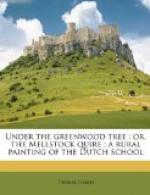Dewy and son, TRANTERS and HAULIERS, Mellstock. NB.—Furniture, Coals, Potatoes, Live and Dead Stock, removed to any distance on the shortest notice.
Mr. Maybold leant over the parapet of the bridge and looked into the river. He saw—without heeding—how the water came rapidly from beneath the arches, glided down a little steep, then spread itself over a pool in which dace, trout, and minnows sported at ease among the long green locks of weed that lay heaving and sinking with their roots towards the current. At the end of ten minutes spent leaning thus, he drew from his pocket the letter to his friend, tore it deliberately into such minute fragments that scarcely two syllables remained in juxtaposition, and sent the whole handful of shreds fluttering into the water. Here he watched them eddy, dart, and turn, as they were carried downwards towards the ocean and gradually disappeared from his view. Finally he moved off, and pursued his way at a rapid pace back again to Mellstock Vicarage.
Nerving himself by a long and intense effort, he sat down in his study and wrote as follows:
“Dear Miss day,—The meaning of your words, ’the temptation is too strong,’ of your sadness and your tears, has been brought home to me by an accident. I know to-day what I did not know yesterday—that you are not a free woman.
“Why did you not tell me—why
didn’t you? Did you suppose I knew?
No.
Had I known, my conduct in coming
to you as I did would have been
reprehensible.
“But I don’t chide you! Perhaps no blame attaches to you—I can’t tell. Fancy, though my opinion of you is assailed and disturbed in a way which cannot be expressed, I love you still, and my word to you holds good yet. But will you, in justice to an honest man who relies upon your word to him, consider whether, under the circumstances, you can honourably forsake him?—Yours ever sincerely,
“Arthur Maybold.”
He rang the bell. “Tell Charles to take these copybooks and this note to the school at once.”
The maid took the parcel and the letter, and in a few minutes a boy was seen to leave the vicarage gate, with the one under his arm, and the other in his hand. The vicar sat with his hand to his brow, watching the lad as he descended Church Lane and entered the waterside path which intervened between that spot and the school.
Here he was met by another boy, and after a free salutation and pugilistic frisk had passed between the two, the second boy came on his way to the vicarage, and the other vanished out of sight.
The boy came to the door, and a note for Mr. Maybold was brought in.
He knew the writing. Opening the envelope with an unsteady hand, he read the subjoined words:




